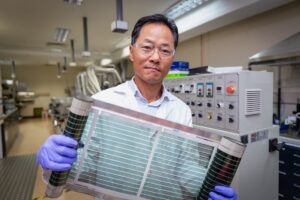A study has found that building solar panels at a specific height above crop plants can reduce surface temperatures on the panel by up to 10°C compared to traditional panels on bare ground.
The study, published in Applied Energy, adds to a growing body of research into agrivoltaics, an innovative use of land that grows crops around solar panels, essentially doubling the land’s utility.
The rapid adoption of renewable energy, critical to avert the worst effects of climate change, will be forced to compete with a massive increase in agricultural production to feed an estimated 10 billion people by mid-century. Agrivoltaics, then, offers a way to make these two competing needs work together.
These sorts of projects are already popping up around the globe, with major growth in China in particular, including a massive 1 GW solar park and goji-berry plantation on the eastern banks of the Yellow River in the Ningxia Province. By some estimates, the agrivoltaics market will reach US$9.3 billion by 2031.
Now, this new research shows how combining solar with crops is good for the panels themselves. Ironically, once a solar panel gets too hot, its efficiency can drop by between ten and 25 per cent.
While other solutions have been proposed, including drilling holes in the panels to increase the uprising of a hot boundary layer of air, growing crops has the added bonus of enhancing profit.
Using a newly developed computer model, the researchers simulated the effects of varying levels of ground cover, different amounts of transpiration from vegetation types, and various panel heights in combination, looking for the perfect configuration that could cool down the local microclimate.
The researchers used an Ontario-based agrivoltaics farm as their test case, and found that placing solar panels over an area covered with soybean plants would reduce panel temperatures by 10°C.
In part, this effect was due to the ability of the soybean plants to reflect light than bare ground, cooling the surface. The ideal panel height was crucial: constructing the panels on legs that kept them four metres above the crops resulted in the optimum cooling of the panels themselves.










